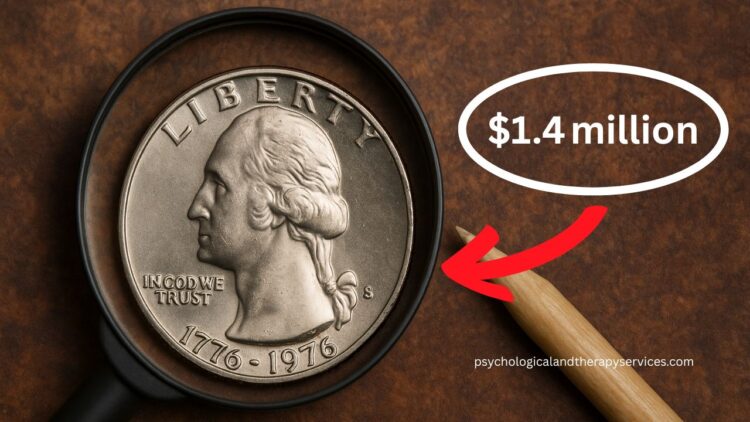A routine coin jar cleanup in Ohio has unearthed a 1976‑S Bicentennial Quarter with double‑die obverse error, igniting an unprecedented $1.4 million auction bidding war. This article dives deep into every fact, figure, and detail behind this stunning discovery.
Background: The 1976 Bicentennial Quarter
- Issued to commemorate America’s 200th anniversary, featuring a Colonial drummer reverse and the dual date “1776–1976.”
- Minted in Philadelphia (no mint mark), Denver (“D”), and San Francisco (“S”).
- Most are common copper‑nickel clad coins—standard pieces of pocket change.
The Discovery: From Change Jar to Headlines
- In early 2025, an individual in Ohio unearthed a 1976‑S (San Francisco‑mint) Bicentennial Quarter from a family coin jar.
- The coin displayed a double‑die obverse error.
- After expert verification, it was auctioned and fetched $1.4 million—a rare auction record for a business‑struck quarter
What Makes This Coin So Valuable?
The enormous value stems from a combination of:
- San Francisco mint mark (“S”) — one of the rarer mint sources.
- A double‑die obverse error: noticeable doubling in date and lettering.
- Extremely low surviving population in circulation.
- Achieving a high grade post‑authentication (though exact grade undisclosed).
- Business‑strike, rather than proof or silver issue—making the $1.4 million price all the more sensational.
Market Context: How Rare Is That?
- A dozen sensational sales of 1976‑S Silver Proof quarters have reached prices up to $1 million recently, but these are proof strikes, not business strikes.
- Many sensational claims ($3 M, $5 M, even $7 M) have circulated online, but most are misinformation or exaggeration. The $1.4 million business‑strike double‑die is confirmed as real.
Key Details at a Glance
| Attribute | Details |
|---|---|
| Coin | 1976 Bicentennial Quarter (“Drummer”), 25¢ |
| Mint Mark | S (San Francisco) |
| Error Type | Double‑Die Obverse |
| Circulation Type | Business Strike (not proof or silver) |
| Discovery Location | Ohio (from family coin jar) |
| Auction Value | $1.4 million |
| Date of Auction Record | Early 2025 |
| Notable Comparisons | Proof silver versions fetched $1 M+, but business‑strike is extremely rare |
| Market Dynamics | Collector fever, scarcity spotlighted in auctions |
Why This Story Matters
- Unexpected treasure potential: Even ordinary coin jars can hide extraordinary value.
- Real, verified error: Distinct from sensationalized internet “million‑dollar quarter” myths.
- A reminder to collectors: Mistakes on business‑struck coins—especially from San Francisco—can command six or seven figures.
- Market credibility: The $1.4 M sale is backed by reputable grading and auction houses, unlike unverified claims.
How to Spot a Potential Million‑Bicentennial Quarter
- Examine the reverse: Must feature the Colonial drummer and dual date “1776–1976.”
- Identify the mint mark: Look for “S” signifying San Francisco.
- Search for obverse errors: Use a magnifying glass to check for doubling in date or letters.
- Check composition and strike type: Business‑strike, not proof or silver; edge shows copper stripe.
- Assess condition: Clean, uncirculated, and minimal defects greatly enhance value.
- Get professional grading through PCGS, NGC, or ANACS before listing or auctioning.
What started as an ordinary coin jar cleanup in Ohio revealed a rare gem: a 1976‑S Bicentennial Quarter carrying a double‑die obverse error that commanded $1.4 million at auction.
This remarkable discovery underscores the hidden potential in everyday change, the power of numismatic expertise, and the enduring fascination collectors have for error coins.
While sensational headlines can mislead, this story stands on verified facts and real market prices—proof that true numismatic treasures sometimes lie waiting in spare change.
FAQs
What makes this Bicentennial Quarter worth $1.4 million?
Because it’s a 1976‑S business‑strike Bicentennial Quarter with a double‑die obverse error, extremely rare in circulation and verified by professional grading and auction results.
Are there other 1976 Bicentennial Quarters worth high values?
Yes—proof coins, especially 40 % silver strikes graded PR70 or Deep Cameo, have sold for up to $1 million. However, those were not business strikes
Should I clean this Bicentennial Quarters if I find one?
Never. Cleaning severely reduces value and can disqualify grading eligibility. Handle with gloves or soft cloth and send for proper authentication.

